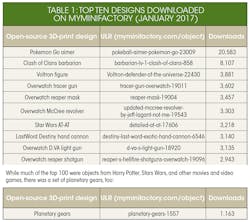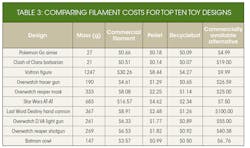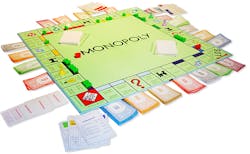Will 3D Printing Disrupt the Board-Game Market?
While many companies have seen the benefit of 3D printing, some people are still unfamiliar with the technology. They still ask if it’s a fad, or if the process is only for hobbyists to print their own chess pieces.
Today, companies are leveraging 3D printing in a number of ways to save time and money. The process is here to stay and finding new avenues to disrupt technology. However, the recently published article “Impact of DIY Home Manufacturing with 3D Printing on the Toy and Game Market” highlighted that printing game pieces is just another market for 3D printing to disrupt. The following information is taken from the article.
When comparing the cost of a mini travel chess set on Amazon to that of a 3D-printed DIY board, you can expect to save about 90% by printing your own. Not to mention you have control of customizing it any way you like. In addition, after returning from your trip with the travel chess set, you could recycle the filament used to make the game and put it toward printing your next project.
People used to make fun of 3D printing, saying there are only so many chess pieces you can print out. Now it’s become serious business—the game market is projected to hit $135 billion by 2020. Sites like MyMiniFactory.com are sharing 3D-print files for game pieces, toys, and other TV, movie, and gaming paraphernalia, allowing people to print their own pieces and characters at home.
The most popular 100 downloaded designs on MyMiniFactory were compared to purchasing the same or similar products at a store to get an idea of how much 3D printing might affect this market. Numbers for filament and electricity were derived from using a Lulzbot Mini 3D printer and three filament types: commercial filament, pellet-extruded filament, and post-consumer waste converted to filament with a recyclebot.
The paper did note that a download doesn’t necessarily mean the product was printed, but it also doesn’t track if the product was printed multiple times either. The cost of 3D printing (O) considered the amount of energy (E) with the national average cost per kilowatt hour (CE), and then added in the cost of cost of filament (CF) times how much was used (mf).
Note: The products were calculated with a 15% infill. Also, a conversion factor of 1000 was used, as the cost of filament was in kilograms and the products or filament used was weighted in grams:
O=E*CE+(CF*mf/1000)
The total operating cost would be subtracted from the commercial cost to get the marginal savings.
The average filament cost of the top downloaded products was: Amazon filament at $9.28, pellets at $2.59, and Recyclebot filament at $1.31.
In a one-month period, 3D printing saved its users more than $5 million in avoided consumer purchases for just the top 100 downloaded designs on MyMiniFactory.com. If extrapolated over a year, just this one 3D-printing repository saves consumers over $60 million a year in offset purchases. MyMiniFactory currently has 26,355 published designs as of April 30, 2017. This means the study only looked at 0.38% of the overall downloads.
The paper concluded that, “It can be safely concluded that the open-source 3D printing community is already having more than $100 million/year [impact] on the toy and game market. As the microeconomic savings are significant for individual consumers and the number of desktop 3D printer users continues to climb, this impact can be expected to grow.”
The Results
If you noticed the planetary gears seemed to have disappeared in Table 3 of the report, they did. Joshua Pearce, one of the authors of the study, said they couldn’t find a one-to-one comparison for the pricing and it was therefore dropped from the list.
Not everything that was printed had a cost advantage. For example, some cosplay items were more expensive. However, the ability to customize a piece like this on a 3D printer would probably make it more desirable. Moreover, 3D printing was beneficial in this space because some cosplay products were not available in the commercial market.
How 3D Printing is Changing the Game
If printing at home continues to gain in popularity, and users see it as a viable product with an easy return on investment through printing simple household parts, decorations, and gaming pieces, the multi-billion dollar the toy industry might fight for stronger copyright and trademark infringement laws to keep market shares from being disrupted.
Nonetheless, a new market of open-source games is already trying to expand this market. With “save the planet board games,” you can 2D-print everything you need, such as the board and cards, and stick it to a piece of cardboard or cereal box. Then you can 3D-print the pieces, dice, or anything else. This was analyzed, too, and found to save 67% to 91% in cost.
This is not the original Monopoly game, but is just outside of the copyright laws. This shows that popular games could be altered, printed, and still be legal. But this trend might prompt people to start thinking of their own games to play. In addition, imagine all of the sweet D&D dice you could print! (By Horst Frank at the German language Wikipedia, CC BY-SA 3.0, https://commons.wikimedia.org/w/index.php?curid=3627036)
Ultimately, this is like saying that it is cheaper to make your own anything—washing detergent, tables, even food. Everyone knows it is cheaper and could instill a sense of pride, skill, or accomplishment, but the detergent, furniture, and restaurant industries are still here and going strong.
This is a great idea, but based on previous experiences, this will not destroy the gaming or cheap plastic widget industry. The numbers, such as the $5 million saved in avoid purchases, probably weren’t actually avoided purchases. It’s possible the reason those items were printed for pennies on the dollar was because the person that printed them wasn’t going to purchase the product anyway. It was only printed due to the reduced cost and increased convenience. It’s more of, “I printed it because it was there,” not because it was something they were actually going to buy.
This doesn’t mean 3D printing isn’t disruptive or amazing, it is just that. The best thing that might happen from this trend is it might drive the recycled filament processes and equipment to become more popular. At least this way we can reuse the plastic from all of the old cheap plastic toys and knick-knacks to make our new cheap plastic toys and knick-knacks. At the least, it will hopefully reduce the amount of the material that ends up in the landfill and oceans.
As for copyright and trademark problems, perhaps this could end up like the music industry. At first, people were illegally downloading music. Then platforms were established that made it generally more beneficial to legally download them or pay for a streaming service that would legally play the music.
The 3D-printing industry is disruptive, but in the end, customers take the path of least resistance. If there is a platform that streamlines the process and makes it easy, that will be the one customers use, whether illegal or more costly.






